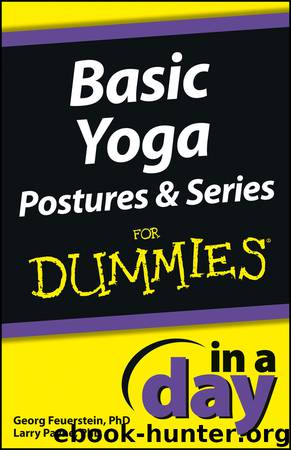Basic Yoga Postures and Series In a Day For Dummies by Georg Feuerstein

Author:Georg Feuerstein
Language: eng
Format: epub
Publisher: Wiley
Published: 2012-09-05T16:00:00+00:00
The standing postures are very versatile. You can use them in the following ways:
As a general warm-up for your practice
In preparation for a specific group of postures (we like to think of the standing forward bends, for example, as a kind of on-ramp to the seated forward bends)
For rest
As the main body of your practice
You can creatively adapt many postures from other groups to a standing position, which you can then use as a learning tool or for therapeutic purposes. Take, for example, the well-known cobra posture, a back bend that many beginning students find hard on the lower back. By performing this same posture in a standing position near a wall, you can use the changed relationship to gravity, the freedom of not having your hips blocked by the floor, and the pressure of your hands on the wall to free your lower back. Then you can apply this newly won understanding about the back in your practice of the more-demanding, traditional form of the cobra posture or any other posture that you choose to modify at the wall.
Exercising Your Options
In this section, we introduce you to several standing postures, describe the step-by-step process for each exercise, and discuss the benefits. Here are a few tips before you get started with the standing postures:
Many of these postures start in the mountain posture, so be sure to check out the “Mountain posture: Tadasana” section.
Follow the instructions for each exercise carefully, including the breathing. Always move into and out of the posture slowly and pause after the inhalation and exhalation (flip to Chapter 1 for more on breathing). Complete each posture by relaxing and returning to the starting place.
When you bend forward from all the standing postures, start with your legs straight (without locking your knees) and then soften your knees when you feel the muscles pulling in the back of your legs.
Choose one of these ways to come up out of a standing forward bend:
• The easiest and safest way is to roll your body up like a rag doll, stacking your vertebrae one on top of another with your head coming up last.
• You can increase the difficulty by bringing your arms up from the sides like wings as you inhale and raise your back.
Work through the steps for each posture we describe in the following sections. Go slowly and focus on your movements and breathing. Spend about five minutes on each posture.
Mountain posture: Tadasana
The mountain posture is the foundation for all the standing postures. Tadasana aligns the body, improves posture and balance, and facilitates breathing. Although this exercise is commonly called the mountain posture, the name for this position is actually palm posture, from the Sanskrit word tada (pronounced tah-dah). Some authorities also refer to this exercise as the tree posture. Here’s how it works:
1. Stand tall but relaxed with your feet at hip width (down from the sits bones, not the outer curves) and hang your arms at your sides, palms turned toward your legs.
Download
This site does not store any files on its server. We only index and link to content provided by other sites. Please contact the content providers to delete copyright contents if any and email us, we'll remove relevant links or contents immediately.
Periodization Training for Sports by Tudor Bompa(8210)
Bodyweight Strength Training by Jay Cardiello(7876)
Born to Run: by Christopher McDougall(7089)
Inner Engineering: A Yogi's Guide to Joy by Sadhguru(6752)
Asking the Right Questions: A Guide to Critical Thinking by M. Neil Browne & Stuart M. Keeley(5708)
The Fat Loss Plan by Joe Wicks(4874)
Bodyweight Strength Training Anatomy by Bret Contreras(4645)
Yoga Anatomy by Kaminoff Leslie(4332)
Dynamic Alignment Through Imagery by Eric Franklin(4176)
Science and Development of Muscle Hypertrophy by Brad Schoenfeld(4103)
ACSM's Complete Guide to Fitness & Health by ACSM(4019)
Exercise Technique Manual for Resistance Training by National Strength & Conditioning Association(4018)
The Four-Pack Revolution by Chael Sonnen & Ryan Parsons(3945)
Bodyweight Strength Training: 12 Weeks to Build Muscle and Burn Fat by Jay Cardiello(3939)
The Ultimate Bodybuilding Cookbook by Kendall Lou Schmidt(3906)
Yoga Anatomy by Leslie Kaminoff & Amy Matthews(3879)
American Kingpin by Nick Bilton(3817)
Nutrition for Sport, Exercise, and Health by Spano Marie & Kruskall Laura & Thomas D. Travis(3742)
Yoga Therapy by Mark Stephens(3721)
